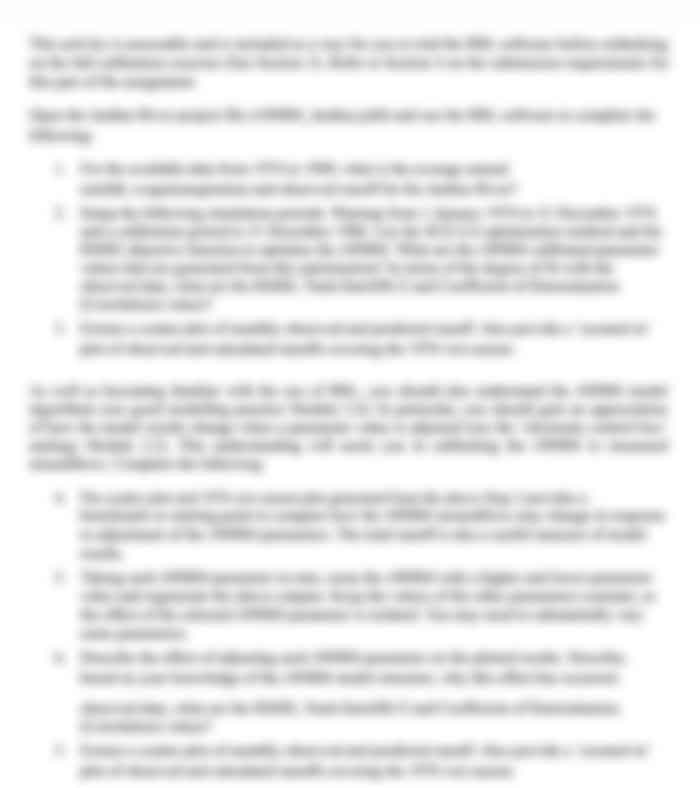25573 Time Series Econometrics Assignment
- Subject Code :
25573
- University :
University of Technology, Sydney Exam Question Bank is not sponsored or endorsed by this college or university.
- Country :
Australia
Question 1
(a) 1 mark, (b)2 marks, (c)2 marks, (d)3 marks
This question is based on the data contained in the Excel fileSHARE.XLS. The file contains daily data on the S&P500 from the 2nd of January, 1998 to the 10th of December, 2001 comprising a total of 1027 observations. The S&P500 index is designatedPRICEin the file. Generate the series for the percentage log return as:
- Assumethe mean equation for returns
.png)
isand the variance equation for returns is anARCH(5). Estimate the model using the first 927 observations. (In EViews, selectObjectNew ObjectEquation. Select estimation methodARCH. In the mean equation box that appears, typeRfollowed byC. In the options box, selectARCH5. In the sample box, type1 927.)
- Refer to your notes for the sign restrictions on coefficients that are needed to ensure that the conditional and unconditional variances are positive and finite and thatis covariance stationary. Are the sign restrictions for the ARCH specification satisfied in your estimated ARCH equation?
- Theconditional standard deviationsare the square roots of the fitted conditional variances from the ARCH estimation. Present a graph of the conditional standard deviation. (After estimating the equation, clickViewConditional SD Graph). Comment.
- Thestandardized residualsare the residuals from the mean equation divided by the conditional standard deviations at each period t. Present a histogram and summary statistics of the standardized residuals. Comment. Are these normally distributed? (After estimating the model, clickProcMake Residual Series. Click for residual type -Standardized. Note the default name for the residual series isresid01. In the series box that appears, clickViewDescriptive StatisticsHistogram and Stats.
Question 2
There is 3 marks for (a) and 2 mark each for (b) i-iii and 1 mark each for (c) i-iii;
This question is based on the data contained in the Excel fileBILLS.xlsx. The file contains monthly data on the yield to maturity on Australian 180-day and 90-day Bank Accepted Bills (denotedbill_180andbill_90, respectively). The data are from July 1992 to September 2014 and are expressed as percent per annum. Construct a series for the term premium defined as:
term = bill_180 bill_90
a. Graph the seriesterm. Perform the appropriate Augmented Dickey-Fuller test on the seriesterm. What do you conclude? Make sure you include the null and alternative hypothesis.
b. Estimate the following models for the term premium and briefly comment on your results for each model. Make sure you make any adjustments as necessarily form your results in part (a)
(i) Model 1: GARCH(1,1)
.png)
(ii) Model 2: GARCH(1,1)-in-Mean
.png)
(In EViews, selectObjectNew ObjectEquation. Select estimation methodARCH. In the mean equation box that appears, typetermfollowed byc. In the options box, select ARCH1and GARCH1. In the ARCH-M option box, selectStd.Dev)
(iii) Model 3: TGARCH(1,1) (with asymmetric adjustment term)
.png)
(In EViews, selectObjectNew ObjectEquation. Select estimation methodARCH. In the mean equation box that appears, typetermfollowed byc. In the options box, select ARCH1, GARCH1and THRESHOLD ORDER1)
c. Re-estimate models 1 to 3 by including the lagged term premium in the mean equation. For example, Model 2 is now:
.png)
Are the results for models 1 to 3 improved by this modification? Justify your answers.

